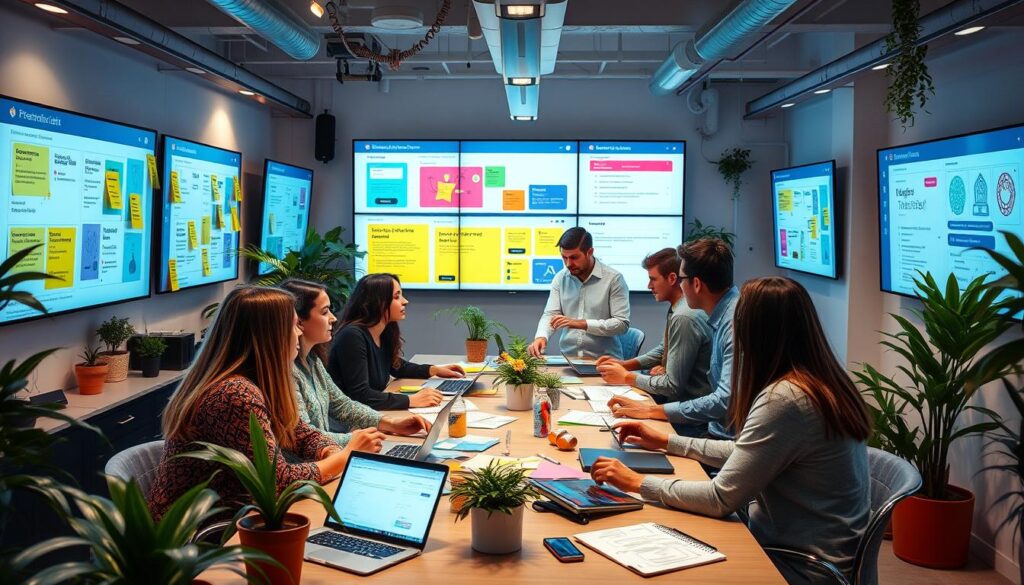Web Design and Review cycles is crucial for web design work

Table of Content
I’ve seen how a good design review can change a website’s success. It’s like a dance, where every small change moves us closer to our goal. We aim to create a website that grabs users’ attention and boosts business.
The digital world keeps changing, so we must be quick to adapt and improve. That’s why design review cycles are key. They help us create amazing user experiences.
Key Takeaways
- Importance of web design review processes in Australia
- Understanding the key components of an effective review system
- Benefits of structured review cycles for project success
- Integrating responsive design principles into the review stages
- Leveraging user experience testing throughout the design phases
Understanding the Importance of Web Design Review Processes
In the fast-paced world of Australian web design, the review process is key to success. By using responsive design, website optimisation, and search engine optimisation (SEO), we make websites that look good and work well.
Key Components of an Effective Review System
An effective web design review process has several important parts:
- Clear project milestones and what needs to be done
- Regular feedback sessions with everyone involved
- Checklists for technical, design, and content needs
- Testing and quality checks
- Tools for feedback and keeping track of changes
Benefits of Structured Review Cycles
Structured review systems bring many benefits to our web design projects:
- They help make websites better with responsive design and website optimisation through feedback.
- They boost search engine optimisation (SEO) by making sure content and structure are right.
- They save time and money by finding and fixing problems early.
- They make clients happier and projects more successful through teamwork and openness.
Impact on Project Success Rates
Research shows that web design projects with good review cycles do better than those without. By focusing on review and quality, we create websites that meet and exceed client needs. This drives growth and success for our Australian web design business.
Web Design and Round of Reviews: Essential Steps for Quality Assurance
Creating a website that looks good and is easy to use is key for Australian businesses. We need a detailed review process to check every part of the web design. This makes sure the website looks great and works well for everyone.
First, we need to know what the project needs and what it aims to do. We gather feedback from important people, set clear goals, and make sure the design follows web standards. This helps us start the review process with a clear plan.
- We do several design reviews, focusing on things like layout, fonts, colors, and how easy it is to use.
- We get feedback from many people, like experts, users, and those who check for accessibility. This helps us review everything thoroughly.
- We use a system to keep track of changes, manage updates, and have a record of all changes made during the review.
- We also use tools that let us work together in real time. This is especially helpful for teams that work from different places.
By following this method, we can make our online presence better. This leads to a great user experience and helps our businesses succeed in the long run.
| Review Stage | Focus Area | Key Objectives |
|---|---|---|
| Initial Design Review | Wireframes, Layout, and Information Architecture | Ensure the proposed design aligns with user requirements and project goals |
| Usability Review | User Interface (UI) and Interaction Design | Assess the intuitiveness and ease of navigation for end-users |
| Accessibility Review | Web Accessibility Standards | Validate compliance with WCAG guidelines and identify any barriers to inclusivity |
| Performance Review | Website Speed and Optimisation | Optimise page load times and ensure the website performs efficiently across devices |
“Effective web design review cycles are the cornerstone of creating exceptional, user-centric digital experiences.”
By having a strong web design review process, Australian businesses can make sure their website is not just pretty but also works well. This approach helps us create a website that is easy to use and enjoyable for everyone.
Building a Strong Foundation: Initial Design Planning
Creating a great web design needs careful planning and a solid plan. In Australia, web design projects start with a key phase – initial design planning. This stage sets the base for the whole web development, making sure users have a smooth experience and the site works well.
Stakeholder Input and Requirements Gathering
We start by listening to what key people want. We talk to clients, designers, and developers to get the project’s goals, who it’s for, and what it needs. This way, we make sure our design meets everyone’s expectations and goes beyond what they hoped for.
Setting Clear Project Milestones
It’s important to set clear goals for the project. We work with clients to set realistic times, what needs to be done, and important checks during the design and build. This helps us keep on track, see how we’re doing, and make changes when needed to make the project a success.
Creating Design Guidelines
- Make a detailed style guide that shows the look and feel, including fonts, colors, and branding.
- Set rules for the user interface (UI) design to make sure the site looks the same everywhere.
- Use responsive design to make sure the site works well on all devices and sizes.
- Work with developers to make code that can be used again, making the site easier to update and keep.
By starting with solid design planning, we set up a web design project for success in Australia. This detailed approach helps us create a site that looks good, is easy to use, and works well. It meets our clients’ needs and what their audience wants.
Implementing Responsive Design Principles in Review Stages
Responsive design is at the core of our web development. We know how important it is for Australian businesses to reach out to many users. We make sure websites work well on all devices and screen sizes.
We start by checking how well the website handles different screen sizes. We look at things like how images and text change, and how easy it is to navigate. This ensures users have a great experience, no matter what device they use.
- We set clear guidelines for responsive design and breakpoints.
- We regularly check how the website looks on different devices.
- We listen to what users say to find any problems.
- We make quick changes to improve how the website works.
| Responsive Design Considerations | Key Evaluation Criteria |
|---|---|
| Layout and Structure | Fluid grid, flexible images and media, CSS media queries |
| Navigation and User Interface | Responsive menus, touch-friendly interactions, intuitive layout |
| Content Adaptation | Optimal text, image and multimedia scaling, content prioritisation |
By focusing on responsive design, we make sure our clients’ websites are top-notch. They look great and work well on all devices. This way, we create websites that truly connect with users, no matter their device choice.
User Experience Testing Throughout Design Phases
Creating a successful website starts with understanding user experience (UX). We must focus on continuous testing and feedback. This ensures our designs meet the needs and preferences of Australian users.
Gathering User Feedback
Getting user feedback is key to improving our web designs. We use different methods to gather insights, such as:
- Conducting user surveys and interviews to understand their pain points and expectations
- Organising usability testing sessions to observe how users interact with our prototype designs
- Analysing user data and heatmaps to identify areas of friction or confusion on the website
Implementing UX Improvements
With user feedback in hand, we can make specific improvements. These might include refining the site’s structure, enhancing the design, or making user flows smoother. All based on what users tell us.
Measuring User Satisfaction
We also need to keep checking if our efforts are working. We use metrics like:
- Net Promoter Score (NPS) to gauge customer loyalty and advocacy
- Customer Satisfaction (CSAT) to understand overall satisfaction levels
- System Usability Scale (SUS) to evaluate the usability of our website
By testing user experience at every design stage, we build websites that Australians love. These sites are accessible and user-focused.
Optimising Website Performance During Review Cycles
As web design experts, we know how vital website optimisation is. During web design project review cycles, we aim to boost website performance. This ensures it meets top standards, enhancing user experience and search engine optimisation (SEO) and website optimisation efforts.
Front-end development is a key area for website performance optimisation. We carefully check the code, making sure it’s clean and efficient. We also optimise images, reduce HTTP requests, and use caching to speed up page loads.
- We do detailed audits of the website’s front-end code to find and fix performance issues.
- We use lazy loading to delay loading non-essential resources until they’re needed.
- We optimise the website’s content delivery network (CDN) to ensure fast asset delivery, especially for international users.
We also work on improving search engine optimisation (SEO) during reviews. This includes checking the website’s structure, metadata, and content. We make sure they follow best practices and target the right keywords.
| Optimisation Technique | Impact on Website Performance |
|---|---|
| Code Optimisation | Reduces page load times and improves overall website responsiveness. |
| Image Optimisation | Decreases file sizes and bandwidth usage, leading to faster page loads. |
| CDN Configuration | Enhances content delivery speed, especially for global audiences. |
| SEO Optimisations | Improves the website’s visibility and ranking in search engine results. |
By focusing on website optimisation throughout the review cycles, we create fast, efficient, and high-performing websites. These websites not only please our clients but also rank well in search engines. This drives more traffic and conversions.
“Optimising website performance is not a one-time task, but a continuous process that must be woven into every stage of the web design review cycle.”
Collaborative Tools and Platforms for Design Reviews
In the fast-paced world of Australian web design, teamwork is key to success. We look at the top tools for managing design reviews. These include software, communication tips, and systems for keeping track of changes.
Popular Review Management Software
Australian web design teams use powerful software for reviews. Figma, InVision, and Zeplin are top choices. They offer a place for feedback, tracking changes, and smooth teamwork.
These tools work well with content management systems (CMS) and user interface (UI) design. They make communication and keeping track of changes easy.
Communication Best Practices
- Use clear channels like email, instant messaging, and video calls for quick feedback.
- Make sure everyone can share their thoughts and ideas freely.
- Keep a record of design choices, changes, and what to do next. This helps everyone stay on track.
Version Control Systems
Good version control is crucial for teamwork in web design. Git and GitHub help teams manage changes and keep everything in sync. This makes it easy to see who did what and when.
It also means you can go back to earlier versions if needed. This keeps everyone on the same page and makes progress clear.
| Tool | Key Features | Pricing |
|---|---|---|
| Figma | Collaborative design, prototyping, and version control | Free for individual, paid plans for teams |
| InVision | Design review, project management, and user testing | Free for individual, paid plans for teams |
| Zeplin | Design handoff, asset management, and developer collaboration | Free for individual, paid plans for teams |
| Git | Distributed version control, branching, and conflict resolution | Free and open-source |
| GitHub | Git-based code hosting, collaboration, and project management | Free for individual, paid plans for teams |

Managing Client Feedback and Revision Requests
Handling client feedback and revision requests is key in web design. Australian businesses aim for a smooth online presence. It’s vital to balance client wishes with design excellence. A strategic feedback management approach ensures our user experience (UX) is top-notch and our responsive design is solid.
Setting up clear communication channels is crucial from the start. We ask clients to share feedback at key project points. This way, we can make changes smoothly without delaying the project. It helps keep everyone’s expectations in check and ensures the final product meets the client’s goals.
When we get revision requests, we look at them through design and user-focused lenses. We give feedback that shows how it might affect the web design and user experience (UX). This open talk helps us find solutions that meet the client’s needs and maintain design quality.
We see feedback as a chance for growth and improvement. We seek user input and make responsive design tweaks based on their feedback. This approach boosts the website’s quality and strengthens our partnership with the client.
“Effective communication and a shared understanding of design principles are the cornerstones of successful web design projects.”
Our client-focused strategy helps Australian businesses reach their digital goals. We deliver outstanding web design and user experience (UX). This teamwork ensures the final product not only meets but exceeds client expectations, driving project success.
Ensuring Web Accessibility Standards Through Reviews
At our web design agency, we know web accessibility is key. It’s not just a checkmark, but a core part of making digital spaces welcoming for everyone. We focus on following Web Content Accessibility Guidelines (WCAG) closely during our design reviews.
WCAG Compliance Checklist
We use a detailed WCAG checklist to ensure our sites are accessible. We check things like web accessibility, text alternatives, easy user interface (UI) navigation, and keyboard use. This way, we make sure our website optimisation helps all users.
Accessibility Testing Methods
- Automated tools to spot accessibility problems
- Manual checks by people with different abilities and tech
- Regular checks and updates during design
Documentation Requirements
Keeping detailed records is crucial for web accessibility. We document our testing, findings, and fixes. This helps us stay compliant and makes future updates easier.
| Accessibility Criteria | Compliance Status | Remediation Actions |
|---|---|---|
| WCAG 2.1 Level AA | Partially Compliant | Enhance color contrast, improve keyboard navigation |
| Assistive Technology Compatibility | Compliant | No further action required |
| Mobile Accessibility | Compliant | No further action required |
By making web accessibility a core part of our design reviews, we aim for inclusivity. Our commitment to accessibility shows our values and dedication to a more inclusive online world.

Content Integration and SEO Considerations
We know how important search engine optimisation (SEO) is for our clients’ websites. We make sure content is well-integrated and optimised for search engines. This is a key part of our web design review process.
We focus on making content engaging and informative, while also optimising it for search engines. We pick the right keywords, write meta descriptions, and structure content to improve visibility on search engine results pages (SERPs).
Leveraging Content Management Systems (CMS) for SEO
Our team uses content management systems (CMS) to make SEO easier. We work with our clients to set up their CMS for SEO success. This includes:
- Optimising page titles, headings, and URL structures
- Implementing schema markup for search engines
- Using tools for sitemap generation and submission
By using CMS features, we help our clients boost their online presence and search engine visibility.
Continuous Improvement through Web Design Reviews
In our web design reviews, we check how our clients’ websites are doing SEO-wise. We look at organic traffic, search rankings, and conversion rates. This helps us find ways to improve.
We integrate content, use CMS features, and keep optimising for search engines. This helps our clients meet their web development and search engine optimisation (SEO) goals. It brings more qualified traffic and conversions to their Australian businesses.
“Effective content integration and SEO go hand-in-hand in creating a successful online presence for our clients.”
Conclusion
Web design and review cycles are key for Australian businesses wanting a successful website. They help create sites that are easy to use. By following structured review processes and focusing on user experience, we can make our web projects stand out.
It’s important to work together during the design and development process. Using the right tools and platforms helps manage feedback, meet accessibility standards, and improve website performance. This way, we can build sites that attract and engage our audience, leading to real business benefits.
If you’re an Australian business looking to improve your online presence, contact us at hello@defyn.com.au. Our web design experts are ready to help you through the design and review process. We aim to make your website a valuable tool for reaching your business goals.










